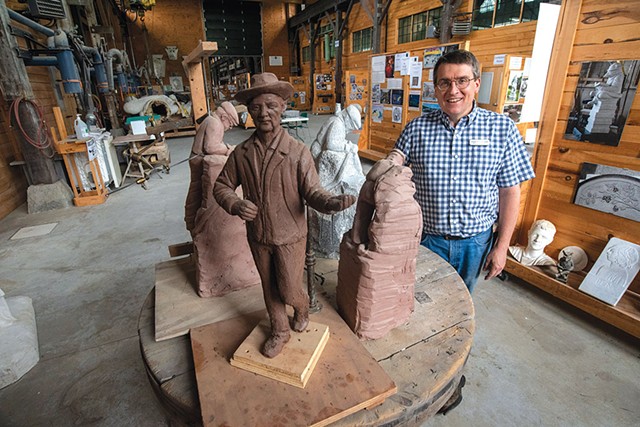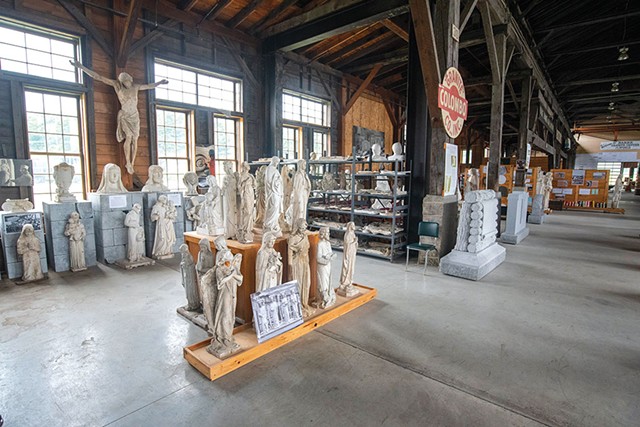
- Jeb Wallace-Brodeur
- Vermont Granite Museum director Scott McLaughlin
Eighteen thousand people worked in the Barre granite industry at its peak in 1929 — quarrying the rock, carving and shaping the stone, creating the tools used in the stone sheds. These days, that number is down to 650, but local manufacturers still need skilled workers.
The Vermont Granite Museum in Barre hopes to provide them. Through a partnership with Norwich University in Northfield, the museum has created a bachelor's degree program aimed at producing a new generation of skilled stone designers and workers.
The program's supporters want to help revitalize a trade that once drew farmworkers from the Vermont hills and immigrants from a dozen countries to work and train in Barre. From about 1900 through the early 1950s, Barre dominated the industry in North America, with granite so uniform in color and consistency that some cemeteries in the U.S. only accepted stones made of it — a tradition that still holds true in some graveyards.
The stone arts program is part of a new bachelor's of science degree in design arts. Norwich is working with other Vermont institutions, such as the Stone Trust in Dummerston, a nonprofit dedicated to the art of building drystone walls, to teach stone-carving and drystone construction.
The design arts program will be housed at Norwich, but students studying stone arts will work in classrooms in the granite museum, a former granite-carving shed in Barre. Students will work by hand with traditional tools, such as hammers and chisels, and by machine to learn the skills to sustain the local granite industry.
"This could become the kind of place where we could create a renaissance in America's stone arts as we merge new and old tools and ideas," said Cara Armstrong, director of Norwich's School of Architecture + Art, home of the new program. "People from around the world would come to this."
Community members and local business leaders started developing the museum and a carving school in 1994. When Barre's Spaulding High School closed its stone trades program in 1997, museum sponsors decided to dedicate almost a third of the museum building — a 27,000-square-foot former Jones Brothers cutting shed built in 1895 — to the stone arts school. The museum itself opened in 2003 and, soon after, started offering workshops in stonecutting and design, many led by local stonecutters.
When museum director Scott McLaughlin set out in 2014 to extend the reach of that program, he searched exhaustively for other stone arts degree programs. He found none in the U.S., though he discovered a few in Europe — including some that have been operating for as long as 600 years.
The European programs are largely focused on creating art for patrons, McLaughlin said. The Barre school will teach stone production with an eye toward the manufacturing industry. He said students will learn to create the public art used in city parks and memorials, as well as architectural elements such as floral designs that are carved into columns.
The students will apprentice with local companies and graduate with the practical skills they need to make a living, said McLaughlin, an adjunct history professor at Norwich.
Granite cutters' apprentices start at $18.50 an hour, said Doug Grahn, the head of the Barre Granite Association, which was founded in 1889 and represents Barre-area quarriers, manufacturers and others in the industry.
"We wanted to make sure they have an apprenticeship so they get a feel for what it is like to be an employee as an artist," McLaughlin said. "At the same time, we'll also be teaching them the art side, where they can design their own products and then find a buyer." They'll learn business skills, as well, such as how to respond to a request for proposals from potential buyers.
Through the new partnership, the school is now a program of Norwich University. In July, the museum received a $30,000 U.S. Department of Agriculture grant to build two classrooms — a design lab where students can create 3D images, and a technology lab with 3D scanners, 3D printers and a CNC machine, a computer-connected tool with a robotic arm that can cut foam blocks, said McLaughlin. On August 9, another federal grant came through, for $100,000, to build two more classrooms.
McLaughlin had just reached an agreement with Norwich regarding the stone-carving program in early 2020 when the pandemic arrived, putting the brakes on its development. Things have started up again, but they are moving slowly. The stone arts program had just one student last year, 58-year-old Patricia Canaday, who works as an administrative assistant on campus. Another student is due to enroll this fall.
McLaughlin plans to start advertising the school this winter, with the goal of enrolling 10 more students in fall 2022.
Canaday, a poet, visual artist and entrepreneur, has worked with athletes as a massage therapist and is comfortable using her hands.
"This captured my imagination," said Canaday. "The tactile nature of massage, and now an opportunity for the more tactile stonework, really, really appeals to me." Canaday is working slowly toward her college degree, taking a few classes at a time.

- Jeb Wallace-Brodeur
- The Vermont Granite Museum in Barre
Supporters say the school — like the museum — will help revive Barre's century-old industry, which is now best known for headstones and faces competitors in a handful of states. While companies still use Vermont granite in headstones, curbs and architectural elements, some American manufacturers, including those in Barre, now import granite blocks from India, South Africa, China and Brazil. McLaughlin doesn't expect that to change, but he'd like every phase of the manufacturing process to stay in the U.S., where workers are unionized.
"Here, if you walk into a granite manufacturing facility, the first thing you see is dust-collecting systems throughout the building," he said. "Workers have steel-toed boots, heavy denim jeans, hearing protection, safety glasses, gloves. Go to a manufacturing facility in India or China, and you may not see any of that, unfortunately."
Like many other manufacturers, granite companies are hiring. The ones in Barre are advertising for machine operators, drafting and CNC specialists, stonecutters, sandblasters, sales staff, and others. With business brisk, now is the time to grow, said Paige Gherardi Lamthi, vice president of Buttura & Gherardi Granite Artisans, the Barre company her great-grandfather founded.
"This is a unique opportunity to bring people in and train them," she said. Demand for carved granite headstones is high, and many workers are reaching retirement age. "We have eight people training in various jobs in production, which is a very high number for us," she said.
Demand for headstones quarried and carved in Barre is greater than in recent years. That's because stones made from imported granite haven't held up over the decades and are showing stains and chipping, said Grahn.
Another reason for the increased demand, said Grahn and Gherardi Lamthi, is that COVID-19 has killed more than 600,000 people in the U.S. More headstones are selling, and the pandemic has also prompted baby boomers to plan ahead for their own mortality, said Grahn.
"Many of our members are reporting sales of double what they were in 2019," he said. And they expect those sales to continue. Grahn said baby boomers are likely to choose headstones even if they are planning for the increasingly popular option of cremation over burial.
A granite headstone can cost many thousands of dollars. "A lot of it is that the baby boomer generation in general has done well financially, a little bit different from some of the other generations, and so they can maybe do things others didn't," Grahn said. "And most everyone wants to be remembered."
The school will also sustain an art form and a culture that has left an indelible impression on the city, according to Kevin Fleming, chair of the psychology department at Norwich and president of the Vermont Academy of Arts & Sciences. Barre's downtown statues and many of the 10,000 memorials in its 85-acre Hope Cemetery were crafted by master sculptors. Some of Hope's granite grave markers feature elaborate portraits, landscapes, or activities such as soccer or car racing that the deceased person loved in life.
It was Fleming who initially proposed that the museum work with Norwich.
"There are very few places on the face of the Earth that have the dynamic that Barre has," Fleming said of the immigrants from Italy and elsewhere who poured into Barre in the 20th century, bringing their language, food and culture.
As for the durable mottled gray, white and black stone that started it all, "that's kind of an untold story," Fleming said. "You can carve it any way you want. It's pure, a very consistent grain; it produces no surprises when you dig down into it. It's perfect inside and out."










Comments
Comments are closed.
From 2014-2020, Seven Days allowed readers to comment on all stories posted on our website. While we've appreciated the suggestions and insights, right now Seven Days is prioritizing our core mission — producing high-quality, responsible local journalism — over moderating online debates between readers.
To criticize, correct or praise our reporting, please send us a letter to the editor or send us a tip. We’ll check it out and report the results.
Online comments may return when we have better tech tools for managing them. Thanks for reading.